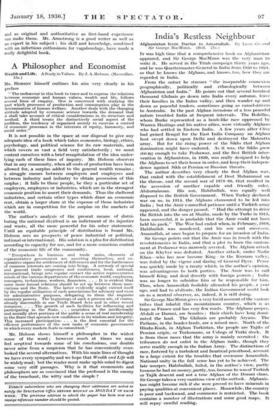India's Restless Neighbour
hr was high time that a comprehensive book on Afghanistan appeared, and Sir George MacMunn was the very man to write it. He served in the Tirah campaign thirty years ago, and he was Quartermaster-General in India from 1920 to 1924, so that he knows the Afghans, and knows, too, how they are regarded in India.
From the outset he stresses " the inseparable connexion geographically, politically and ethnologically between Afghanistan and India." He points out that several hundred thousand Ghilzais go down into India every autumn, leave their families in the Indus valley, and then wander up and down as peaceful traders, sometimes going as camel-drivers to Australia. In the past Afghan invasions of a less peaceful nature troubled India at frequent intervals. The Rohillas, whom Burke represented as a lamb-like race oppressed by Warren Hastings and his native allies, were virtually Afghans who had settled in Eastern India. A few years after Clive
had gained Bengal for the East India Company an Afghan host swept down upon Delhi and destroyed the Mahratta army. But for the rising power of the Sikhs that Afghan domination might have endured. As it was, the Sikhs grew strcng enough to take Peshawar, and the first British inter- vention in Afghanistan, in 1839, was really designed to help the Afghans to set their house in order, and keep their indepen- dence against Sikh or Persian or Russian threats.
The author describes very clearly the first Afghan war, that ended with the establishment of Dost Muhammad on the throne, and the second war of 1878-80, that resulted in the accession of another capable and friendly ruler, Abdurrahman. His son, Habibullah, was equally well disposed to the British Government. When Turkey declared war on us, in 1914, the Afghans clamoured to be led into India ; but the Amir counselled patience until a Turkish army appeared, and the danger passed. " Had the attempt to drive the British into the sea at Shaiba, made by the Turks in 1915, been successful, it is probable that the Amir could not have held his pack." The War had ended when, in February, 1919, Habibullah was murdered, and his son and successor, Amanullah, at once began to prepare for an invasion of India.
Sir George points out that the Amir was in touch with the revolutionaries in India, and that a plot to burn the canton- ment at Peshawar was narrowly averted. The Afghan attack on the Khyber was defeated. Another attack, under Nadir Khan—who has now become King—in the Kurram valley, was foiled by the vigour and daring of General Dyer. Peace was quickly made by a treaty which, in the author's opinion, was advantageous to both parties. The Amir was to call himself King, and deal directly with foreign powers ; India was no longer to subsidise him or be responsible for him. Thus, when Amanullah foolishly alienated his people, a year agO, and had to abdicate, the Indian Government could look on as a neutral observer, as, indeed, it is still doing.
Sir George MacMunn gives a very lucid account of the various tribes that inhabit this mountainous country, which is as large as France and has very few roads. The Afghans proper, Abdali or Durani, are Semites ; their chiefs have long domi- nated the land. The Ghilzais are probably Aryans. The Pathans, in the border-lands, are a mixed race. North of the Hindu-Kush, in Afghan Turkistan, the people are Tajiks of Persian origin; or Turkomans, or Usbegs of Turki stock. It is from these races that the army is mainly recruited ; the tribesmen do not enlist in the Afghan ranks, though they serve readily enough in the Indian Army. The distinctions of race, fostered by a turbulent and fanatical priesthood, account to a large extent for the troubles that overcame Amanullah. National unity in the full sense has yet to be achieved. The late usurper, Habibullah, failed, in the author's view, partly because he had no money, partly, too, because he was of Turkish or Tajik descent and not a true Afghan of the Durani clans. Sir George takes a very cautious view of the outlook. Afghanis- tan might become rich if she were proved to have minerals in paying qualities at convenient places. Meanwhile, the country is poor and backward, and commerce is restricted. The book contains a number of illustrations and some good maps. It will repay careful reading.






































 Previous page
Previous page